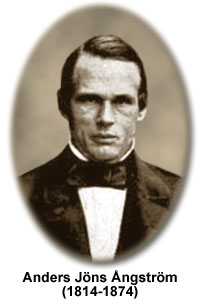Anders Jöns Ångström
(1814-1874)

Anders Ångström was a Swedish physicist, mathematician, and astronomer who is widely considered the father of spectroscopy. His most famous work is the atlas, Researches on the Solar System, which listed the wavelength of over 1000 lines in the solar spectrum. Ångström expressed his results in the unit (one ten-millionth of a millimeter) that now bears his name. The Ångström unit (Å) was formerly used in describing the wavelength of light and in electron microscopy. However, not an official SI unit of length, the Ångström was ultimately replaced by the nanometer.
Educated at the University of Uppsala, in 1839 Ångström became a member of its faculty, and by 1858, succeeded to the chairmanship of the physics department. As the discoverer of hydrogen in the solar atmosphere and later in other stars, he was the first to examine the spectrum of the aurora borealis from his Uppsala observatory. Using a prism to examine spectra, Ångström was able to disprove the then-accepted theory that the northern lights originated from reflected sunlight through sky-borne ice crystals. He demonstrated that the characteristic bright line in the yellow-green light was due to electrically excited oxygen atoms. The Swedish scientist also discovered the relationship between the Fraunhofer lines in the solar spectra and the discontinuous spectra of hot gases. His pyrheliometer, designed for the direct measurement of incident solar radiation, was adopted as an official instrumental standard in 1905. Ironically, Ångström, a chaplain's son, was born August 13, 1814 in Lögdö (Medelpad), Sweden during a solar eclipse.
In thermal conductivity studies, Ångström devised a method to quantify temperature with respect to electrical conductivity. His 1853 research on electric sparks uncovered two superimposed spectra, one from the electrode metal and the other from the gas through which it passes. Ångström's principle of spectral analysis states that incandescent gases emit rays of the same refrangibility as those they can absorb. He also studied geomagnetism.
As a modest, reserved person, despite his important scientific work, Ångström was not immediately recognized neither abroad nor even in his own country. In 1867, he was appointed secretary of the Royal Society of Sciences in Uppsala. Ångström was also a member of the Stockholm Academy, and in 1870, became a Fellow of the Royal Society of London from which he received the prestigious Rumford Medal (1872).
Ångström Unit - A unit of length, equal to 10-10 or 0.0000000001 meters. The symbol used to specify the Ångström unit is Å. This measurement of length was formerly often used in describing the wavelength of light and for size determination in electron microscopy. It is not one of the SI units of length. Abbreviation: AU or au.
The unit, about the size of a hydrogen atom, is named in honor of nineteenth century Swedish physicist Anders Ångström (1814-1874) who coined the measure to describe exceedingly small wavelengths originating from the solar spectrum. Current scientific literature utilizes the Ångström unit to describe atomic and molecular dimensions.
